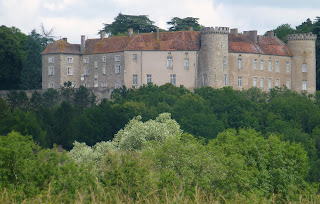 |
| Chateau at Ray-sur-Saone |
We handed in our remote control zapper at the final lock of the canal des Vosges at Corre with a slight feeling of relief. We'd made it through all those locks without any major delay. From here on we are on familiar waters. In fact this will be our third trip along this stretch this year alone. We know the stopping places, where to eat (at least we thought we did), where to shop etc. On the other hand there's a certain lack of excitement -we know exactly what is, or isn't, around the next bend.
We knew, for instance, that despite Corre appearing on our charts in
bold type we would not stop. Instead, we went on to the port at Fouchecourt which has a 6 table restaurant serving reasonable food and run by an expat Belgian with possible ambition as a stand-up comedian (his side-kick is Chocolat the dog). Fouchcourt is one of many small villages along this stretch which are pretty, have a church and often a lavoir but nothing in the way of shops. Conflandey is another. Here there's an attractively situated chateau on an island in the middle of the river and a free pontoon mooring alongside a now closed restaurant but the village at the top of the hill, once again, has no shops (although there is a building which declares itself to be a covered market but no sign of when, if ever, it opens).
We made stops at Port-sur-Soane which has some shops and restaurants but suffers horrendously from the constant truck traffic along its main street which carries the road across the canal and the river and then at Scey-sur-Saone which is a lovely mooring and thriving village (with an excellent baker's) down an embranchment of the river.
There are 2 tunnels on the Petite Saone - the Saint Albin and the Savoyeux neither of which presents any particular problem once you're inside. They are controlled by traffic lights which may mean quite a wait depending on the traffic coming the other way.
 |
| Saint Albin tunnel approaches |
This is a popular hire boat cruising area and as we are now into the slightly cheaper hire season it is still quite busy. And so it was that we found ourselves firmly aground at the side of the canal whilst waiting around for three qaurters of an hour for the Savoyeux tunnel. Our stern somehow became hung up over a mud bank which meant moving a heavy wieght as far forward as possible whilst at the same time freeing the back end with the engine and a barge pole. No prizes for guessing which heavy weight had to do the figurehead impression. The tunnel approaches are under video surveillance so that the keeper can decide when to change the lights so I suppose we provided some light relief for him.
 |
| Waiting our turn at the Savoyeux tunnel |
Then, onto Gray where, for 4 days, we availed ourselves of the free electricity and water provided along the quayside. Thank you Gray.
 |
| This fisherman at Gray couldn't believe his luck |
We've been to Gray several times but never eaten out so this time we stirred ourselves and hiked up the steep hill to the old, upper town to a restaurant in a building dating back to the 1600s - a restaurant with stars no less.
I don't know which is the big night out in Gray but it's certainly not a Thursday. We were the only customers.
The restaurant itself was much as you'd expect in a medieval building; rafters, an enormous carved stone fireplace, red plush upholstered dining chairs and a huge gilded mirror.
 |
| Empty restaurant, Gray |
 |
| One of the two diners |
The young waiter was obviously a trainee and possibly new to France. In fact it may even have been his first night as he was accompanied by the owner as he took our order, was told how to write it down and what he should ask us. Oddly, one of the things he had to ask was did we want a dessert because if so it had to be ordered at the same time as the entree and main. Put on the spot we decided not to bother.We could hear more explanations in the kitchen regarding the food and we began to wonder if the chef was also a trainee. An hour or so later, when when we were finishing our main course we were a little surprised to see the waiter appear from the kitchen dressed in hat and jacket and on his way home. Apparently no back door then. The owner was by this time at the desk at the entrance and the kitchen completely silent. Were the trainee waiter and the chef, in fact,one and the same person? We finished our meals and wine, paid our bill and left. We were no sooner out of the door when we heard the great medieval bolts being slid into place and the lights went out. It was all of 9.30 and we made or way back to the boat through completely deserted, silent streets. And what of the food? Well, it was ok. Nothing to write home about though- or award stars for.
 |
| Bonjour from Auxonne. One of the turrets on the fortifications around the town |
We are now in Auxonne which is only a couple of hours from St Jean de Losne where we will leave the boat for winter. We still have about 10 days left before we need to go into port in order to do the jobs necessary before we fly home so perhaps we'll make a trip along the Doubs once again as far as Dole. Last decision for the year.
 |
| The garrison town of Auxonne |









